Nvidia GeForce GTX 760 2 GB Graphics Card Review

The third and most likely the final graphics card this year in Nvidia’s new GeForce GTX 7×0 family has just been officially launched. We studied its peculiarities and are going to show you how it compares against the previous generation competitors.
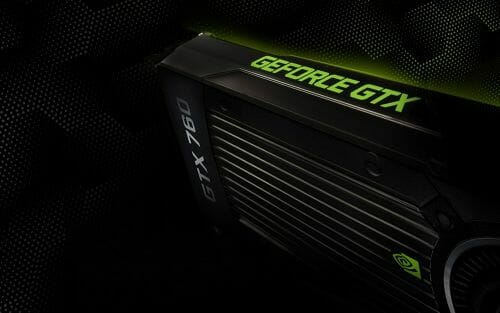
This product isn’t that straightforward in terms of performance and positioning in Nvidia’s model range as well as against AMD’s alternatives, and we’re going to sort it all out in this review.
Specifications and Market Positioning
The Nvidia GeForce GTX 760 specs are listed in the table in comparison with the Nvidia GeForce GTX 770 and GeForce GTX 660 Ti:
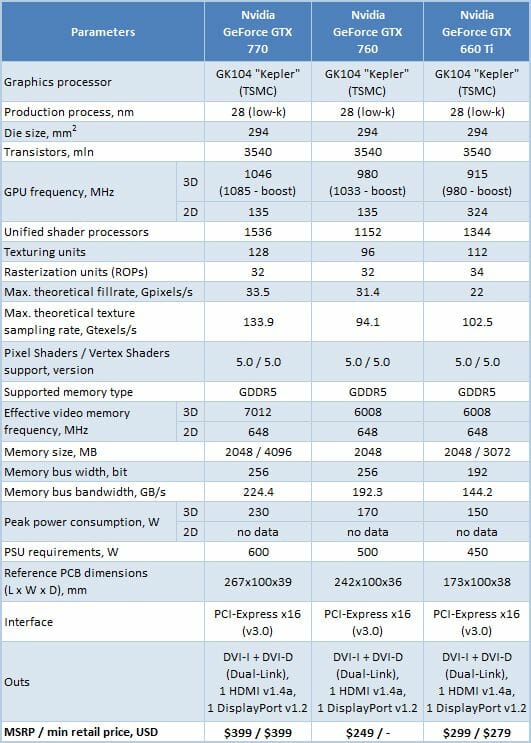
According to them, the GeForce GTX 760 is based on the same Kepler family GK104 GPU as the GTX 770 and GTX 660 Ti. Its base GPU clock rate in 3D applications is 66 MHz lower than that of the GTX 770 and 65 MHz higher compared to the GTX 660 Ti, or exactly halfway between these two models. Then, the GTX 760 has fewer unified shader processors: by 384 (or 25%) and by 192 (14.3%) compared to the GTX 760 and the GTX 660 Ti, respectively. It also has a proportionally smaller number of texture-mapping units. The GeForce GTX 760 has the same number of raster operators as the GTX 770, namely 32. The key feature of the new card is its broader memory bus, which is now 256 bits wide compared to the GTX 760’s 192-bit bus. The memory frequency being the same at 6008 MHz, the GTX 760 has a 33.4% higher memory bandwidth in comparison with the GTX 660 Ti, so we can expect the former to beat the latter at high resolutions or when full-screen antialiasing is enabled.
As for marketing positioning, the GeForce GTX 760 documentation for promotional purposes shows considerable performance improvements over the GeForce GTX 275 (does anyone remember its specs?) and the GeForce GTX 560:
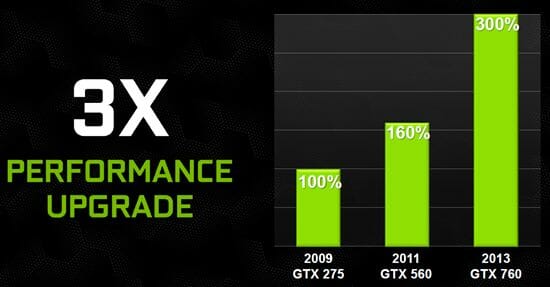
Of course, the GeForce GTX 760 is going to compete with completely different graphics cards in reality. Nvidia is, however, optimistic about the new card’s performance, claiming that it is faster than the regular and Boost versions of the more expensive AMD Radeon HD 7950.
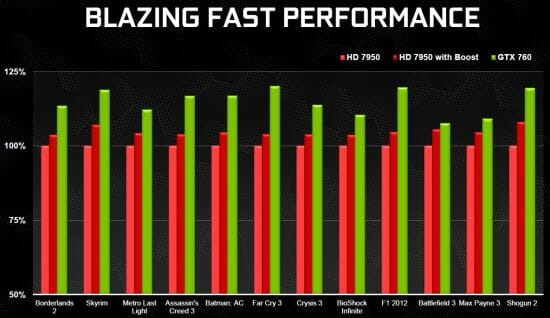
Getting a little ahead, we can tell you that the actual picture is somewhat different.
In its current product line-up Nvidia puts the GeForce GTX 760 between the GeForce GTX 770 and GTX 660 (the former is likely to replace the GeForce GTX 660 Ti):
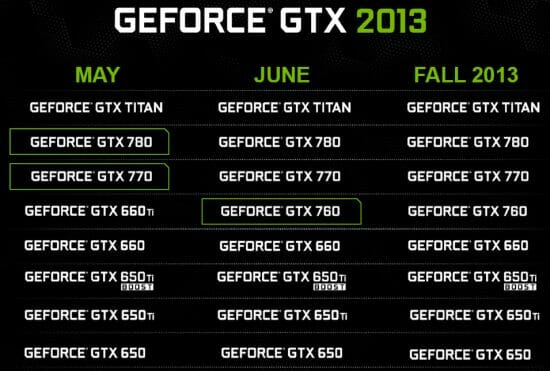
According to this slide, we are unlikely to see any new cards from Nvidia until the end of 2013.
Now let’s check out the reference GeForce GTX 760.
Design and Functionality
The official GeForce GTX 760 announcement has already been accompanied with announcements of its original versions with exclusive coolers and factory overclocking from nearly all of Nvidia partners. We will try to get some of them for our tests but today we will be talking about the reference sample.
The GeForce GTX 760 looks simpler than the GTX 780 or GTX 770, resembling the GeForce GTX 650 Ti Boost in its appearance:
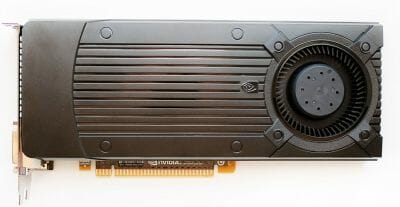
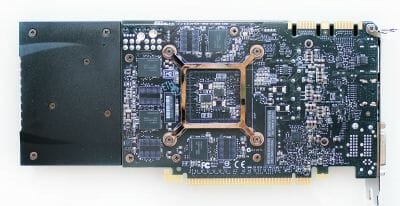
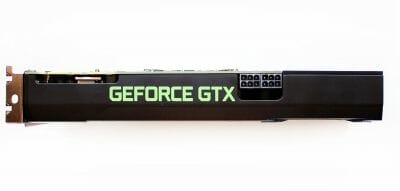
The sculpted plastic casing of the cooling system covers the entire face side of the card. On the reverse side we can see a short PCB extended by a plastic fan enclosure. The green words “GeForce GTX” on the top edge are not highlighted. The card is 242 mm long.
The Nvidia GeForce GTX 760 is equipped with three video outputs: dual-link DVI-I and DVI-D, HDMI 1.4a, and DisplayPort 1.2.
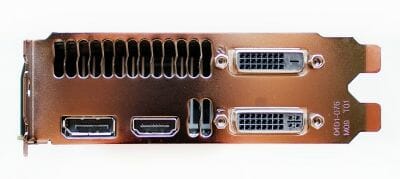
The GTX 760 is no different from the top-end models of Nvidia’s new series in terms of video interfaces. It also has two MIO connectors (for joining two, three or even four graphics cards in SLI mode) and two 6-pin power connectors in their conventional locations:
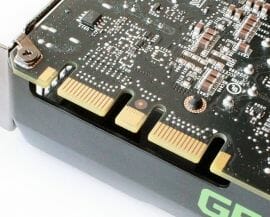
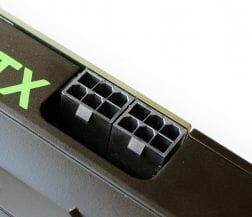
According to the specifications, the GeForce GTX 760 consumes no more than 170 watts of power, which is 60 lower than required by the GTX 770 and 20 watts higher than required by the GTX 660 Ti which also has two 6-pin power connectors.
It would have been odd for Nvidia to develop a completely new PCB for a graphics card with such specs as the GeForce GTX 760 has. So it is based on the PCB from the GeForce GTX 660 Ti that the new model has come to replace.
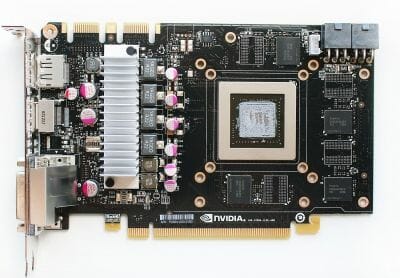
The power system is located in the front part of the device and cooled with a large aluminum heatsink. It incorporates 4+2+1 phases (GPU+memory+PLL).
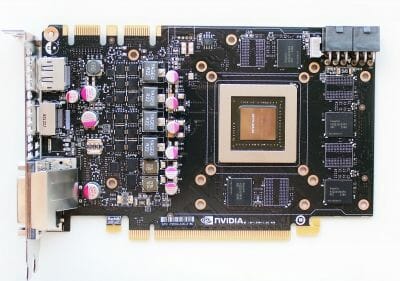
It is managed by an ON Semiconductor NCP5392P controller you can find on the reverse side of the PCB.
By the way, there are empty places for memory chips on both sides of the PCB, so we can expect 4-gigabyte versions of the GeForce GTX 760 in the future.
The GK104 revision A2 chip of our sample was manufactured on 28nm tech process in Taiwan on the 15th week of 2013 (in mid-April).
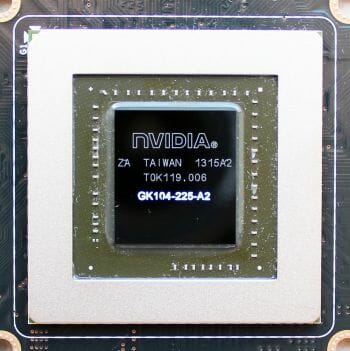
The GPU die is only 294 sq. mm, incorporating 3540 million transistors. The base GPU clock rate in 3D applications is 980 MHz. It can be officially boosted to 1033 MHz but in our tests, with maximum power and temperature targets, the GPU clock rate would peak up to 1137 MHz, which is a good 100 MHz above the specified level. The effect of the GPU Boost 2.0 technology is obvious here.
The GPU clock rate is dropped to 135 MHz in 2D applications while its voltage is lowered from 1.2 to 0.862 volts.
The reference GeForce GTX 760 carries 2 gigabytes of GDDR5 memory in FCBGA-packaged chips located on both sides of the PCB. These are Hynix’s H5GQ2H24AFR R0C components:
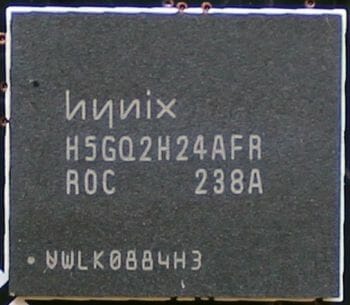
The memory chips are rated for 6000 MHz and the GeForce GTX 760 uses that memory clock rate in 3D applications. In 2D mode the memory frequency is lowered to 648 MHz. The memory bus width is mentioned above in the specifications section.
Here is what the GPU-Z utility can report about the GeForce GTX 760:
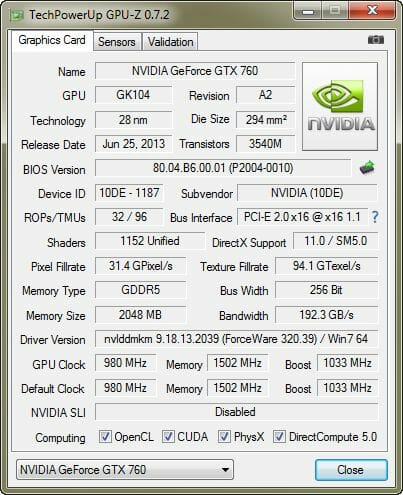
The ASIC quality of our GPU is 80.3%:
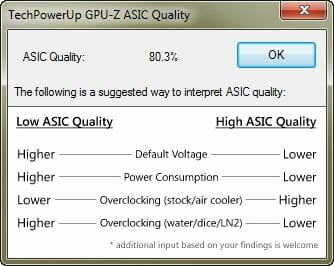
Cooling System
The default cooling system deployed on the GeForce GTX 760 is exceedingly simple, consisting of a small aluminum heatsink with a copper base, a 67mm radial fan and a plastic casing:
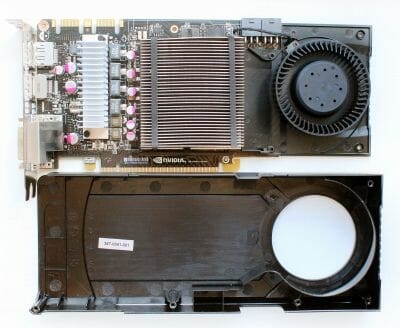
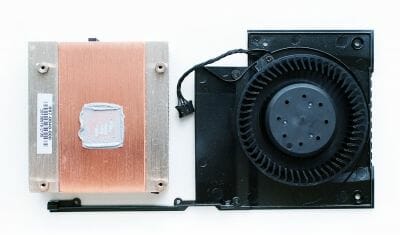
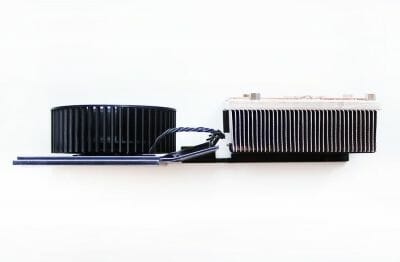
The fan features an optimized PWM-based regulation algorithm previously implemented on the GTX 780 and GTX 770:
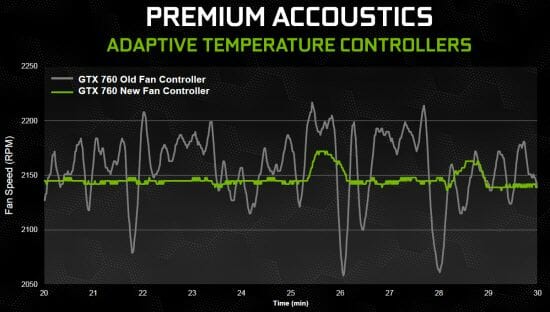
The new adaptive algorithm ensures a smoother control over the speed of the fan, making the graphics card more comfortable acoustically.
To check out the card’s temperature we used five runs of the Aliens vs. Predator (2010) benchmark at the highest visual quality settings, at a resolution of 2560×1440 pixels, and with 16x anisotropic filtering and 4x MSAA. We used MSI Afterburner 3.0.0 beta 10 and GPU-Z version 0.7.1/0.7.2 for monitoring of temperatures inside the closed system case, which configuration is discussed in detail in the following chapter of the review. All tests were performed at 25°C room temperature.
Now let’s see how efficient the cooler is when its fan is regulated automatically:
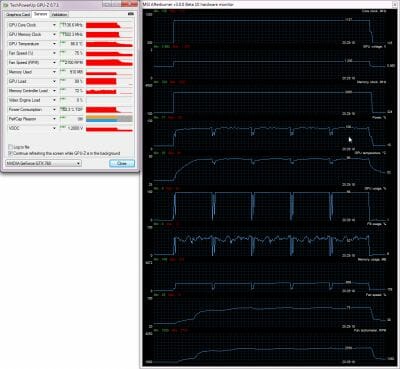
So, the card’s simpler cooler can barely cope with its GPU. The latter is 86°C hot at peak load while the fan accelerates to an impressive 2700 RPM. The monitoring graph shows the fan change its speed smoothly as the load grows up. When the load is removed and the card switches to 2D mode, the fan quickly slows down.
At the maximum speed of the fan (3570 RPM), the temperature was lower by 11°C, so the GPU was 75°C hot.
Overclocking Potential
Considering the low efficiency of the reference cooler, we set its fan at the maximum speed for our overclocking experiments. We overclocked our GeForce GTX 760 using EVGA Precision X version 4.2.0. After setting the Power and Temperature Targets at their maximums, we managed to increase the card’s GPU and memory frequencies by 115 and 1120 MHz, respectively, without any stability and image quality issues.
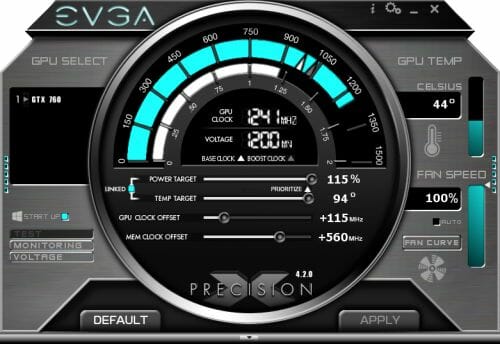
The resulting clock rates of the overclocked Nvidia GeForce GTX 760 were 1095/1148/7128 MHz:
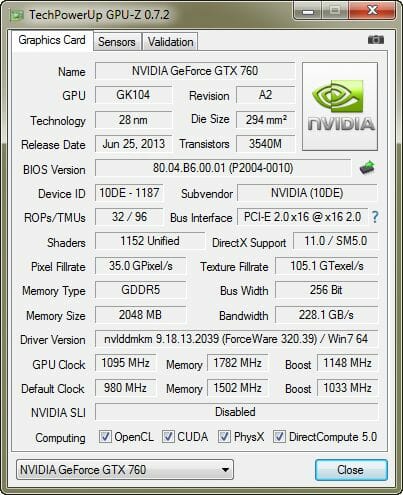
The GPU frequency of the overclocked card would peak up to 1241 MHz whereas the peak GPU temperature was 76°C.
Power Consumption
We measured the power consumption of our testbed equipped with different graphics cards using a multifunctional Zalman ZM-MFC3 panel which can report how much power a computer (without the monitor) draws from a wall outlet. There were two test modes: 2D (editing documents in Microsoft Word or web surfing) and 3D. In the latter case the load was created by four runs of the introductory “Swamp” scene in Crysis 3 game at 2560×1440 with maximum image quality settings, but without MSAA.
We will compare the power consumption of the Nvidia GeForce GTX 760 with that of the Nvidia GeForce GTX 770, Gigabyte GeForce GTX 670, ASUS GeForce GTX 660 Ti and HIS Radeon HD 7950 Boost Edition at default and overclocked frequencies.
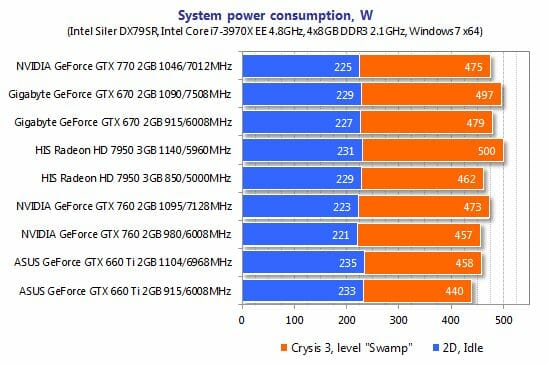
We don’t see any substantial differences in power consumption. The GeForce GTX 760 configuration needs about as much power as the system with an overclocked GeForce GTX 660 Ti and somewhat less than the Radeon HD 7950 system. The power consumption doesn’t grow up much when the graphics cards are overclocked, so every configuration can be powered by a 550-watt PSU.
Testbed Configuration and Testing Methodology
All participating graphics cards were tested in a system with the following configuration:
- Mainboard: Intel Siler DX79SI (Intel X79 Express, LGA 2011, BIOS 0559 from 03/05/2013);
- CPU: Intel Core i7-3970X Extreme Edition, 3.5/4.0 GHz (Sandy Bridge-E, C2, 1.1 V, 2 x 256 KB L2, 15 MB L3);
- CPU cooler: Phanteks PH-TC14PE (2 x Corsair AF140 fans at 900 RPM);
- Thermal interface: ARCTIC MX-4;
- Graphics cards:
- NVIDIA GeForce GTX 770 3 GB 1046/1085/7012 MHz;
- NVIDIA GeForce GTX 760 2 GB 980/1033/6008 MHz and 1095/1148/7128 MHz;
- Gigabyte GeForce GTX 670 2 GB Ultra Durable (GV-N670OC-2GD) 915/994/6008 MHz and 1090/1169/7508 MHz;
- HIS 7950 IceQ X² Boost Clock 3 GB (H795QMC3G2M) 850/5000 MHz and 1140/5960 MHz;
- ASUS GeForce GTX 660 Ti DirectCU II TOP 2 GB (TI-DC2T-2GD5) 915/993/6008 MHz and 1104/1182/6968 MHz;
- System memory: DDR3 4×8 GB G.SKILL TridentX F3-2133C9Q-32GTX (2133 MHz, 9-11-11-31, 1.6 V);
- System drive: Crucial m4 256 GB SSD (SATA-III,CT256M4SSD2, BIOS v0009);
- Drive for programs and games: Western Digital VelociRaptor (300GB, SATA-II, 10000 RPM, 16MB cache, NCQ) inside Scythe Quiet Drive 3.5” HDD silencer and cooler;
- Backup drive: Samsung Ecogreen F4 HD204UI (SATA-II, 2 TB, 5400 RPM, 32 MB, NCQ);
- System case: Antec Twelve Hundred (front panel: three Noiseblocker NB-Multiframe S-Series MF12-S2 fans at 1020 RPM; back panel: two Noiseblocker NB-BlackSilentPRO PL-1 fans at 1020 RPM; top panel: standard 200 mm fan at 400 RPM);
- Control and monitoring panel: Zalman ZM-MFC3;
- Power supply: Corsair AX1200i 1200 W (with a default 120 mm fan);
- Monitor: 27” Samsung S27A850D (DVI-I, 2560×1440, 60 Hz).
There are five graphic cards participating in our today’s test session and only one of them, GeForce GTX 770 is tested in its non-overclocked mode at the nominal frequencies:
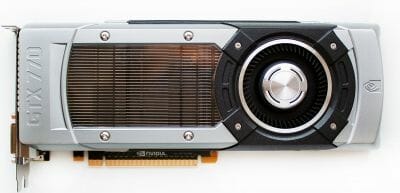
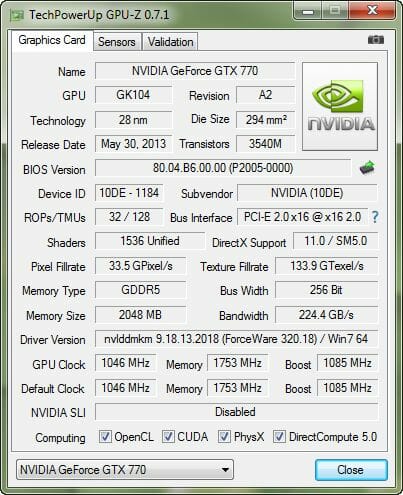
This approach is quite logical, as it is GTX 770 that is a top reference point for the GTX 760 and most likely some other testing participants.
The remaining three graphics cards were tested at their nominal frequencies as well as at the maximum clocks for these specific graphics cards:
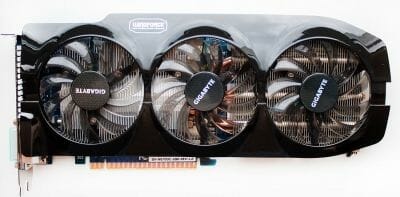
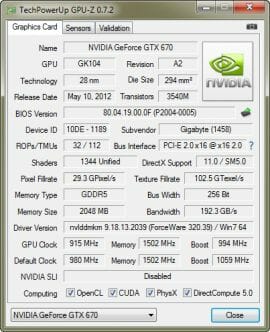
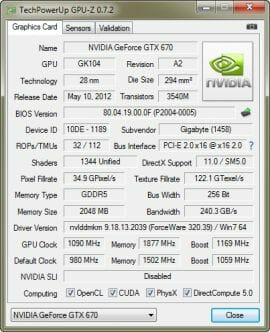
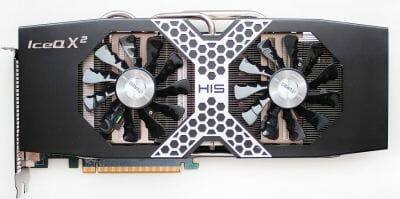
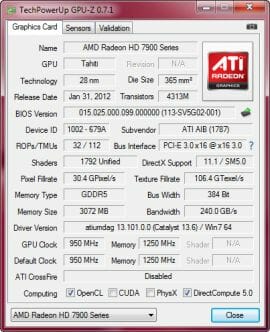
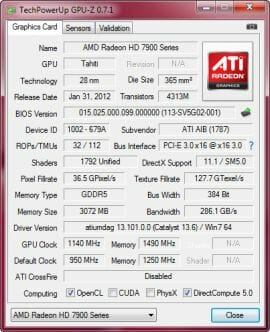
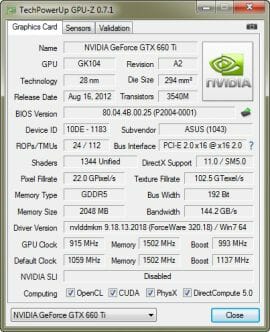
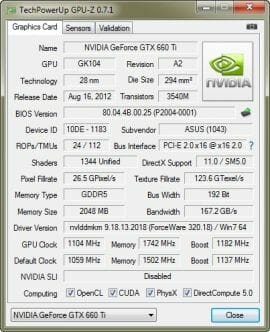
In order to lower the dependence of the graphics cards performance on the overall platform speed, I overclocked our 32 nm six-core CPU with the multiplier set at 48x, BCLK frequency set at 100 MHz and “Load-Line Calibration” enabled to 4.8 GHz. The processor Vcore was increased to 1.38 V in the mainboard BIOS:
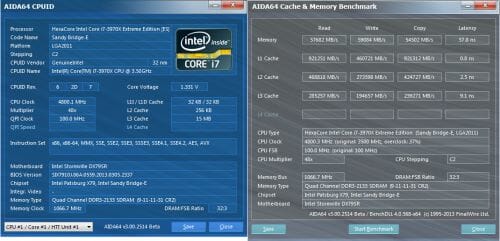
Hyper-Threading technology was enabled. 16 GB of system DDR3 memory worked at 2.133 GHz frequency with 9-11-11-31 timings and 1.6V voltage.
The test session started on June 20, 2013. All tests were performed in Microsoft Windows 7 Ultimate x64 SP1 with all critical updates as of that date and the following drivers:
- Intel Chipset Drivers 9.4.0.1017 WHQL from 03/27/2013 for the mainboard chipset;
- DirectX End-User Runtimes libraries from November 30, 2010;
- AMD Catalyst 13.6 beta 2 driver from 06/04/2013 + Catalyst Application Profiles 13.5 (CAP1) for AMD based graphics cards;
- Nvidia GeForce 320.39 Beta driver for GTX 760 and GeForce 320.18 WHQL driver from 05/23/2013 for other Nvidia graphics cards.
We tested the graphics cards performance in two resolutions: 1920×1080 and 2560×1440. The tests were performed in two image quality modes: “Quality+AF16x” – default texturing quality in the drivers with enabled 16x anisotropic filtering and “Quality+ AF16x+MSAA 4x(8x)” with enabled 16x anisotropic filtering and full screen 4x or 8x antialiasing, in those cases when the average fps rate remained high enough for comfortable gaming experience. We enabled anisotropic filtering and full-screen anti-aliasing from the game settings. If the corresponding options were missing, we changed these settings in the Control Panels of Catalyst and GeForce drivers. We also disabled Vsync there. There were no other changes in the driver settings.
Our benchmarking suite underwent some modifications. Besides the traditional updates of the games that already are in this list, we added two new titles to it. They are GRID 2 auto racing simulator and Company of Heroes 2 (beta version) real-time strategy. As a result, our suite includes two popular semi-synthetic benchmarks and 12 resource-consuming games of various genres:
- 3DMark 2013 (DirectX 9/11) – version 1.0, benchmarks in “Cloud Gate”, “Fire Strike” and “Fire Strike Extreme” scenes;
- Unigine Valley Bench (DirectX 11) – version 1.0, maximum image quality settings, AF16x and(or) MSAA 4x, 1980×1080 resolution;
- Metro 2033: The Last Refuge (DirectX 10/11) – version 1.2, maximum graphics quality settings, official benchmark, “High” image quality settings; tesselation, DOF and MSAA4x disabled; AAA aliasing enabled, two consecutive runs of the “Frontline” scene;
- Total War: Shogun 2: Fall of the Samurai (DirectX 11) – version 1.1.0, built-in benchmark (Sekigahara battle) at maximum graphics quality settings and enabled MSAA 8x in one of the test modes;
- Battlefield 3 (DirectX 11) – version 1.4, all image quality settings set to “Ultra”, two successive runs of a scripted scene from the beginning of the “Going Hunting” mission 110 seconds long;
- Sniper Elite V2 Benchmark (DirectX 11) – version 1.05, we used Adrenaline Sniper Elite V2 Benchmark Tool v1.0.0.2 BETA with maximum graphics quality settings (“Ultra” profile), Advanced Shadows: HIGH, Ambient Occlusion: ON, Stereo 3D: OFF, two sequential test runs;
- Sleeping Dogs (DirectX 11) – version 1.5, we used Adrenaline Sleeping Dogs Benchmark Tool v1.0.2.1 with maximum image quality settings, Hi-Res Textures pack installed, FPS Limiter and V-Sync disabled, two consecutive runs of the built-in benchmark with quality antialiasing at Normal and Extreme levels;
- Hitman: Absolution (DirectX 11) – version 1.0.446.0, built-in test with Ultra image quality settings, with enabled tessellation, FXAA and global lighting;
- Crysis 3 (DirectX 11) – version 1.0.1.3, all graphics quality settings at maximum, Motion Blur amount – Medium, lens flares – on, FXAA and MSAA4x modes enabled, two consecutive runs of a scripted scene from the beginning of the “Swamp” mission 110 seconds long;
- Tomb Raider (2013) (DirectX 11) – version 1.1.743.0, we used Adrenaline Benchmark Tool, all image quality settings set to “Ultra”, V-Sync disabled, FXAA and 2x SSAA antialiasing enabled, TessFX technology activated, two consecutive runs of the benchmark built into the game;
- BioShock Infinite (DirectX 11) – version 1.1.21.26939, we used Adrenaline Action Benchmark Tool v1.0.2.1, two consecutive runs of the built-in benchmark with “Ultra” and “Ultra+DOF” quality settings;
- Metro: Last Light (DirectX 11) – version 1.0.2, we used built-in benchmark for two consecutive runs of the D6 scene. All image quality and tessellation settings were at “Very High”, “Advanced PhysX technology was enabled, we tested with and without SSAA antialiasing;
- GRID 2 (DirectX 11) – version 1.0.82.5097, we used built-in benchmark, graphics image quality settings were at their maximum in all aspects, the tests were run with and without MSAA 8x antialiasing with eight cars on the Chicago track;
- Company of Heroes 2 beta (DirectX 11) – version 3.0.0.9614, two consecutive runs of the integrated benchmark at maximum image quality and physics effects settings.
If the game allowed recording the minimal fps readings, they were also added to the charts. We ran each game test or benchmark twice and took the best result for the diagrams, but only if the difference between them didn’t exceed 1%. If it did exceed 1%, we ran the tests at least one more time to achieve repeatability of results.
Performance
The tested graphics cards are sorted in the diagrams in the order of descending recommended price. The new generation of Nvidia-based cards, such as GeForce GTX 770 and GTX 760, are marked with turquoise. The older generation is green. The only AMD-based card is red. Let’s get started.
3DMark (2013)
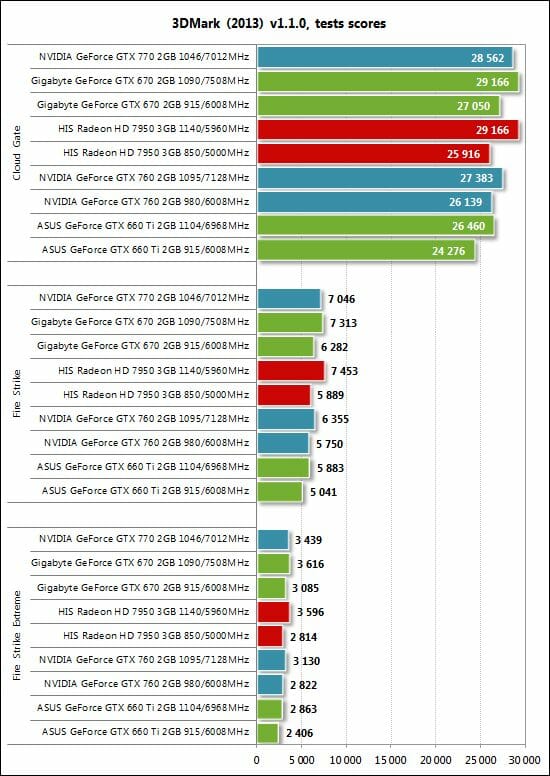
First of all, we can note that the graphics cards all have very close results in 3DMark in every test scene. However, the new GeForce GTX 760 is faster than the GeForce GTX 660 Ti, even if the latter is overclocked. It also looks good against the Radeon HD 7950 but the excellent overclocking potential of the AMD-based solution makes it unrivalled in this test except for the overclocked GeForce GTX 670. Well, this review is not about them.
Unigine Valley Bench
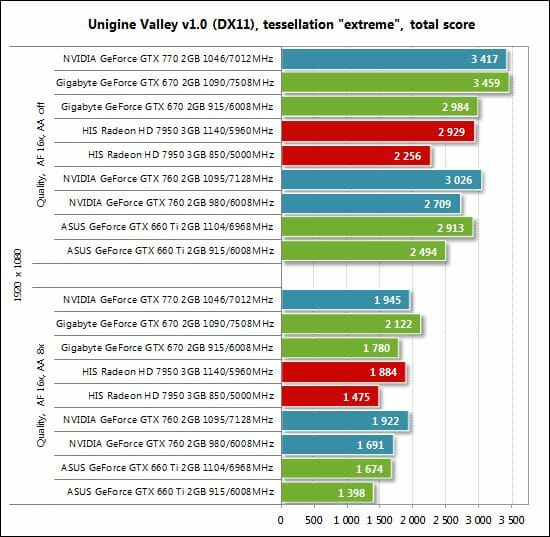
This benchmark showcases the benefits of the 256-bit memory bus implemented in the GeForce GTX 760. The overclocked GeForce GTX 660 Ti beats the default GTX 760 without antialiasing but the newer card goes ahead as soon as we turn on 8x MSAA. Moreover, the GeForce GTX 760 even beats the Radeon HD 7950 here. When overclocked, it can challenge the GeForce GTX 670, which is quite an achievement for a $249 product.
Metro 2033: The Last Refuge
The 256-bit memory bus of the GeForce GTX 760 is even more effective in this game:
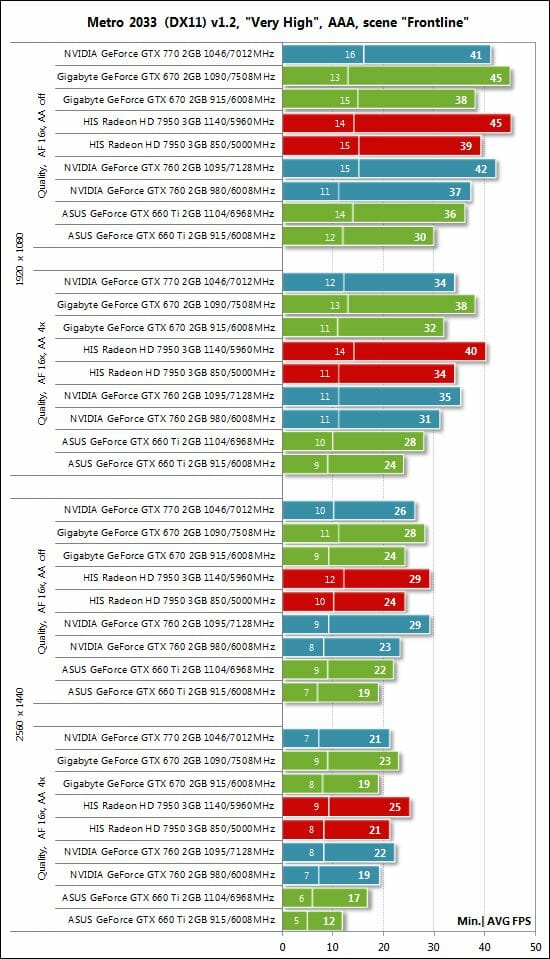
The new card enjoys a 50% advantage over the GeForce GTX 660 Ti – the largest advantage across all the tests! On the other hand, it doesn’t look so good against the Radeon HD 7950, both at the default and overclocked frequencies. AMD-based products have always been superior in Metro 2033: The Last Refuge.
Total War: SHOGUN 2 – Fall of the Samurai
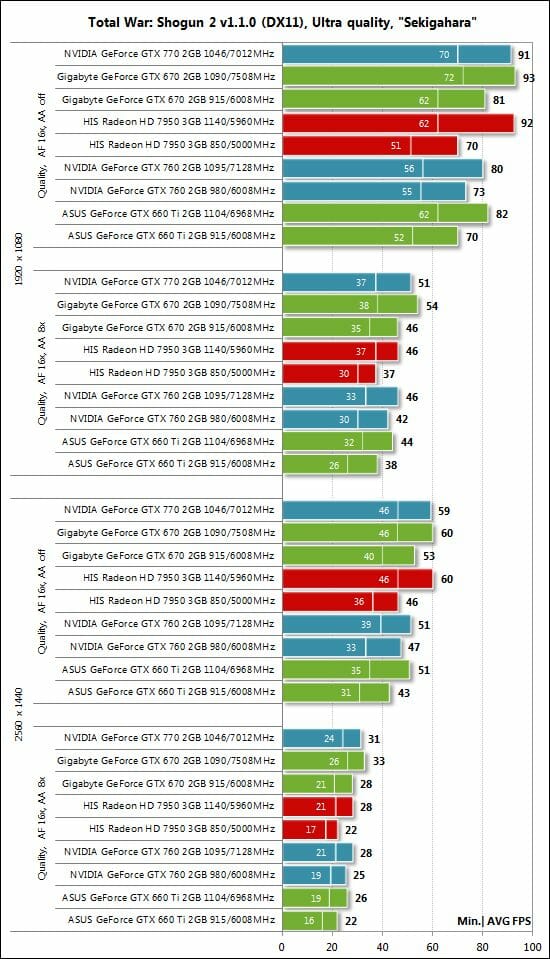
The GeForce GTX 760 is up to 14% faster than the GeForce GTX 660 Ti in this game at the default settings but they deliver the same performance when overclocked. It must also be noted that the new card is competing successfully with the Radeon HD 7950 here.
Battlefield 3
We can see the same standings in this game as in the previous test:
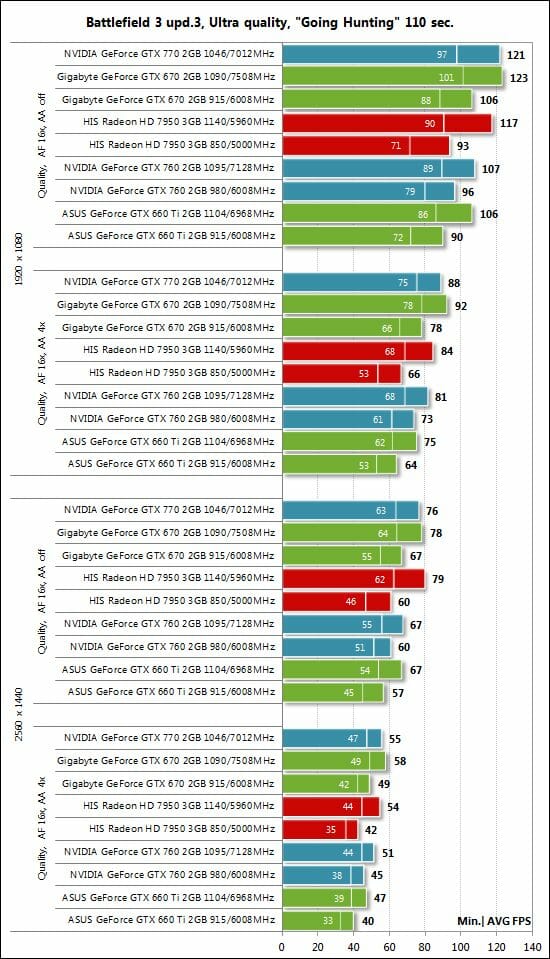
Sniper Elite V2 Benchmark
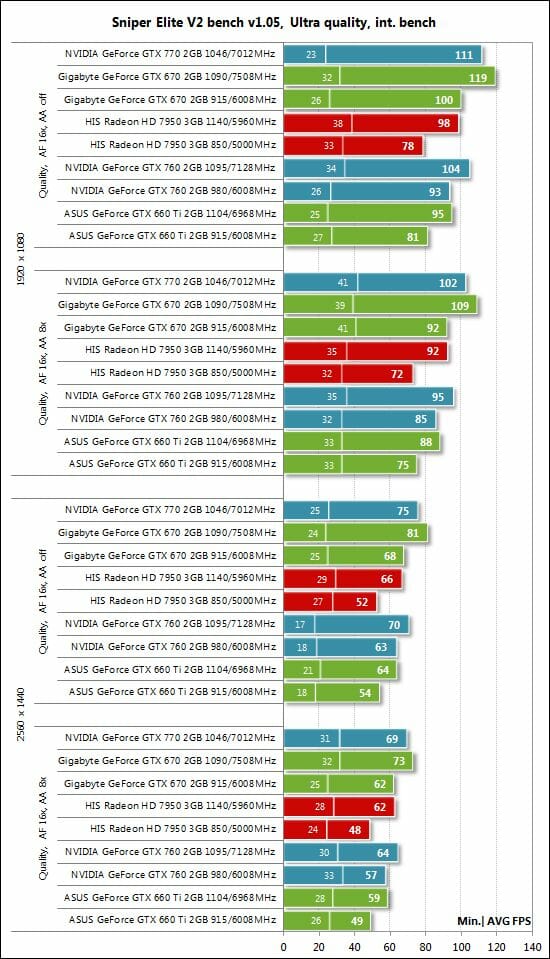
The GeForce GTX 760 is just brilliant in Sniper Elite V2. It is 13-17% ahead of the GeForce GTX 660 Ti at the default settings, so the latter can only catch up with it when overclocked. Then, the GeForce GTX 760 beats the Radeon HD 7950, also at the overclocked settings. And finally, the overclocked GeForce GTX 760 is as fast as the default GeForce GTX 670 while being the cheapest product in this review (in terms of recommended prices).
Sleeping Dogs
AMD-based products have always had an upper hand in this game, but the new card from Nvidia can challenge the Radeon HD 7950:
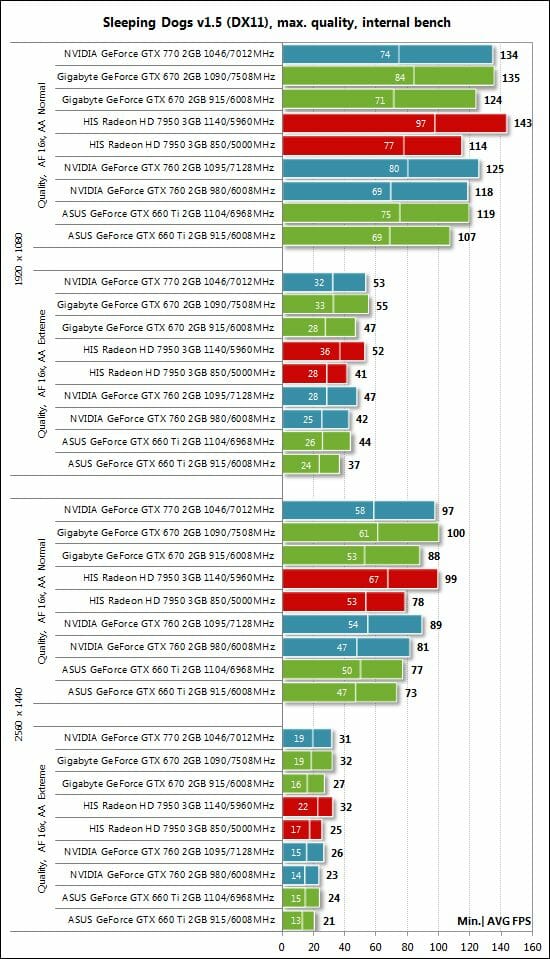
It must be noted, however, that the Radeon HD 7950 goes ahead when overclocked and even beats the default GeForce GTX 770.
Hitman: Absolution
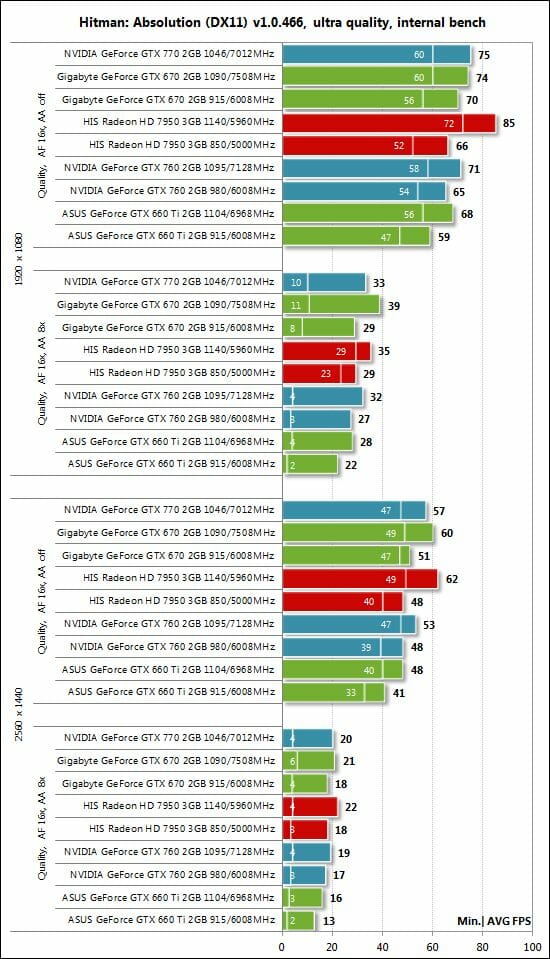
We see the same standings in Hitman: Absolution. The GeForce GTX 760 is still ahead of the GTX 660 Ti, indicating that its 256-bit memory bus is more important than the number of shader processors for resource-consuming games.
Crysis 3
We can see the same overall picture in this game, too:
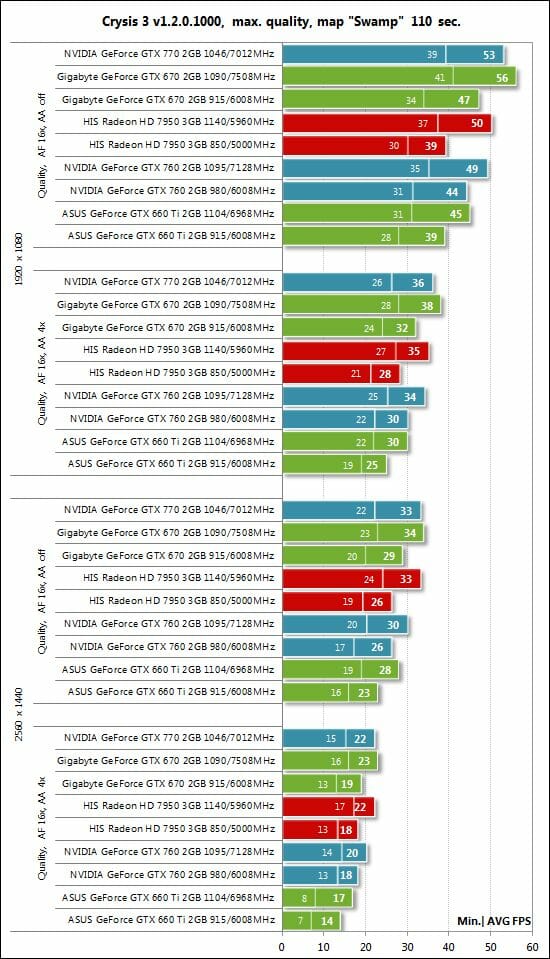
The GeForce GTX 760 is again equal to the Radeon HD 7950 at their default settings but the AMD card is ahead when both are overclocked.
Tomb Raider (2013)
The Radeon HD 7950 is definitely faster here:
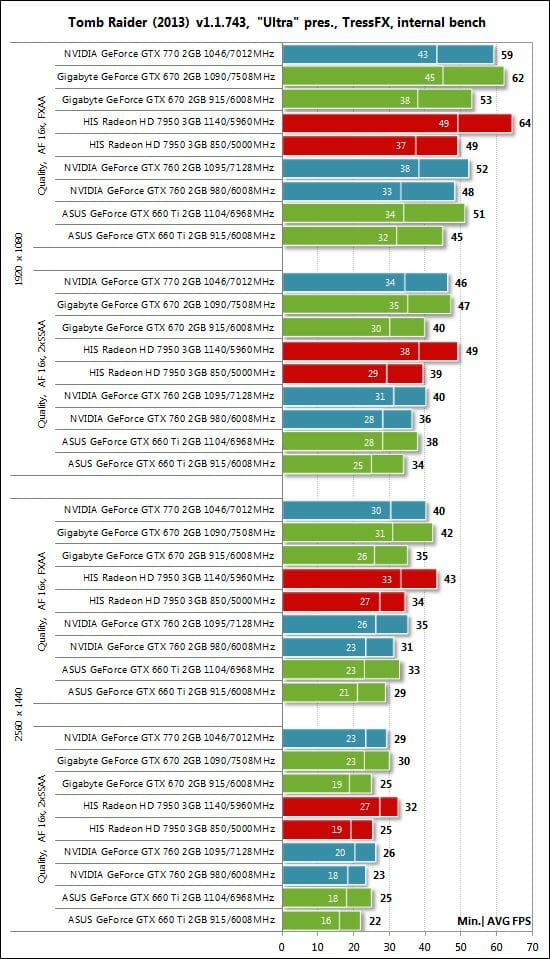
Still, the new card from Nvidia is ahead of the GeForce GTX 660 Ti.
BioShock Infinite
This game produces the same standings as the previous tests:
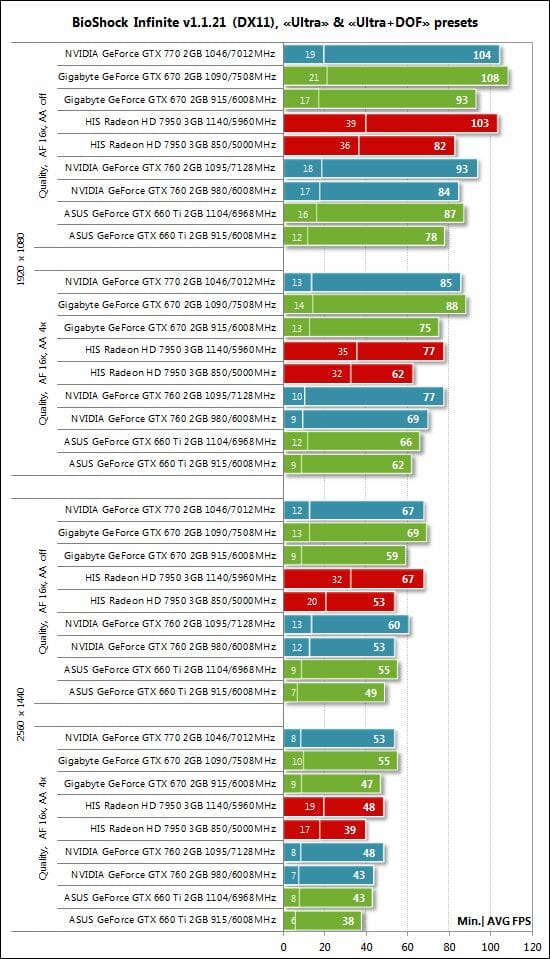
Metro: Last Light
Nvidia beats AMD in this game when the Advanced PhysX technology is turned on.
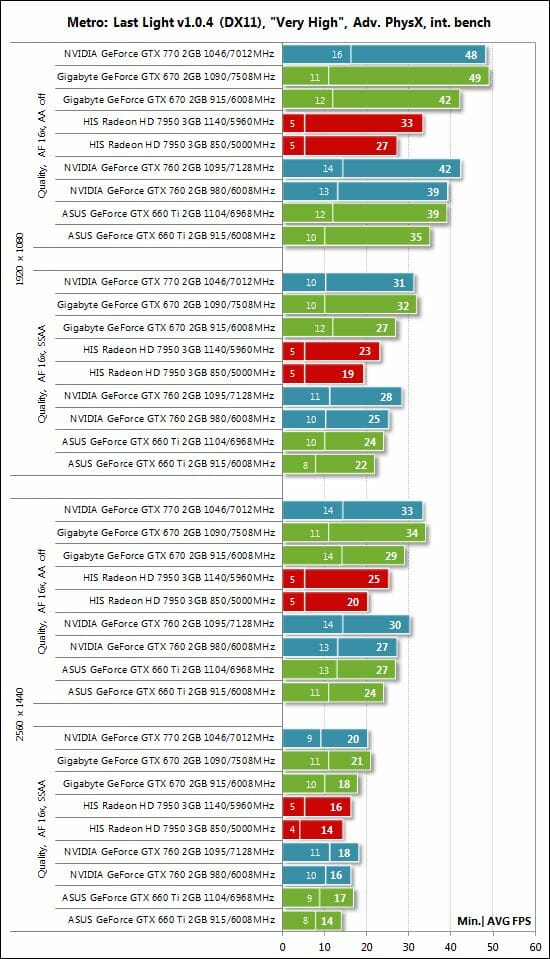
We can see the same gap between the GeForce GTX 760 and GTX 660 Ti as before.
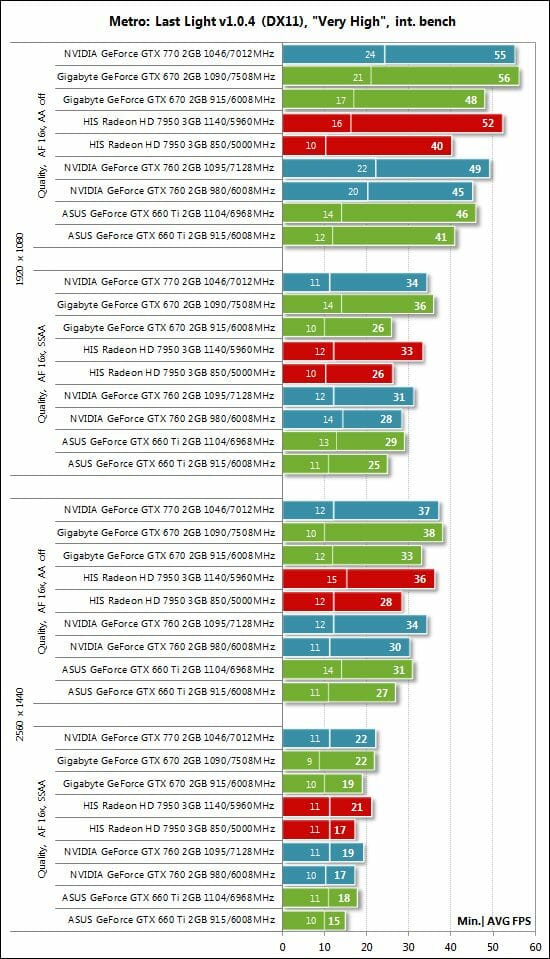
When Advanced PhysX is disabled, the Radeon HD 7950 improves its frame rate but the GeForce GTX 760 remains a little faster at the default settings.
GRID 2
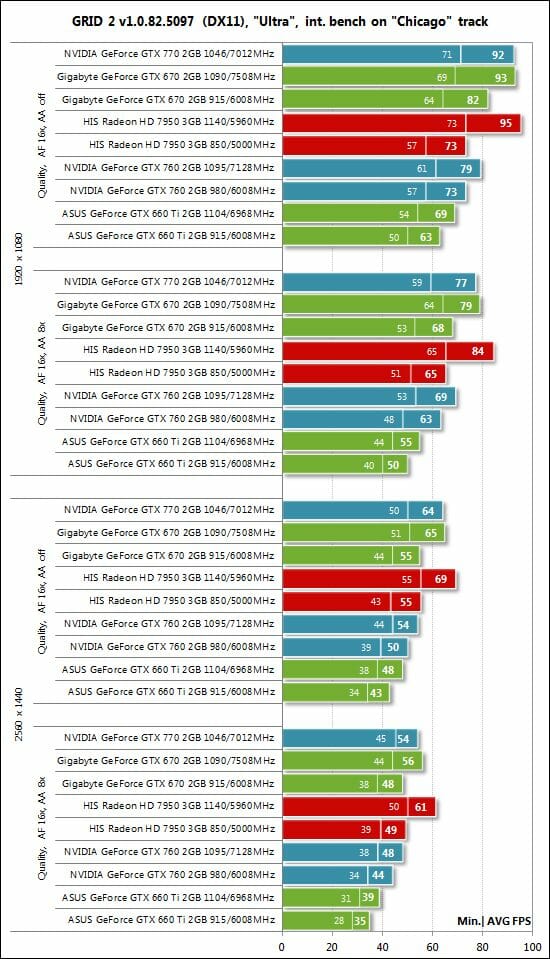
The Radeon HD 7950 wins this test while the Nvidia-based cards have the same standings as in the previous games.
Company of Heroes 2
The Radeon HD 7950 looks good in this new title, too:
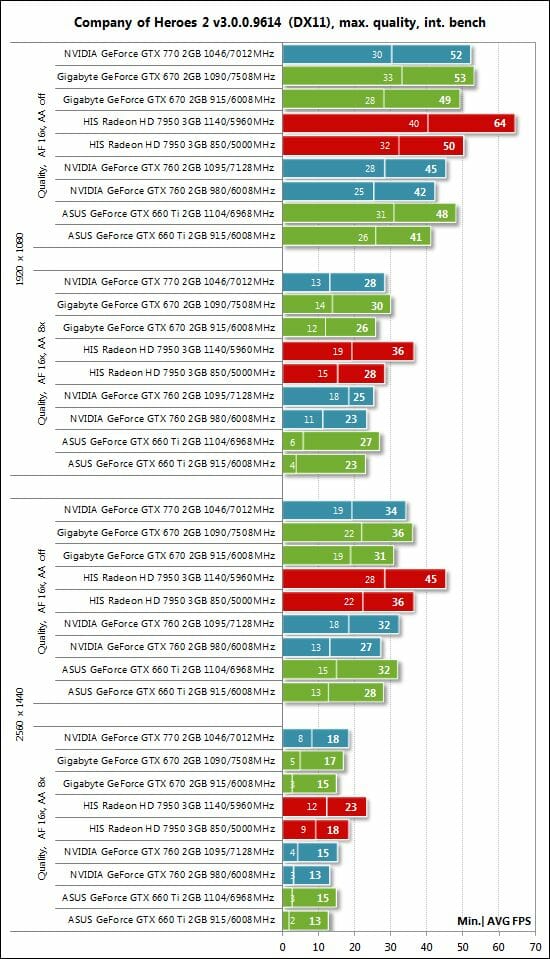
Here is a table with full test results, now we can proceed to performance summary charts.
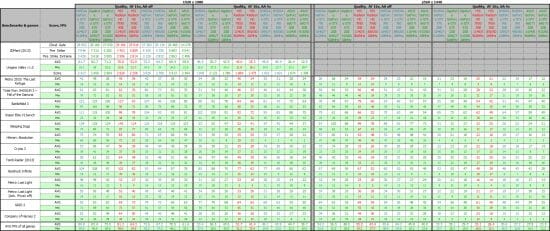
Performance Summary
First of all, let’s see how faster the new GeForce GTX 760 is in comparison with the old GeForce GTX 660 Ti at their default clock rates:
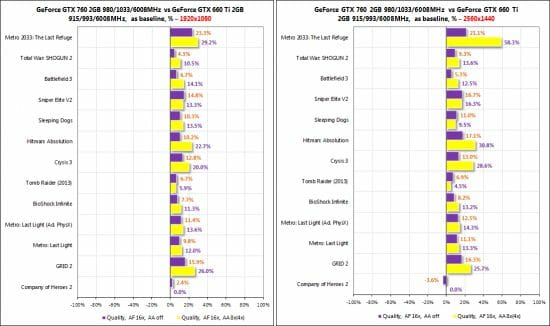
The newer card enjoys the largest advantage in Metro 2033: The Last Refuge and at the AA settings in the other games. It might have been expected since it is in such resource-consuming modes that the broader memory bus should have the biggest effect on performance. The GeForce GTX 760 is an average 10-15% faster than the GeForce GTX 660 Ti at 1920×1080 and 11-18% faster at 2560×1440 across all the tests. That’s good, considering that it’s cheaper.
Now let’s check out the gap between the GeForce GTX 760 and the GeForce GTX 670.
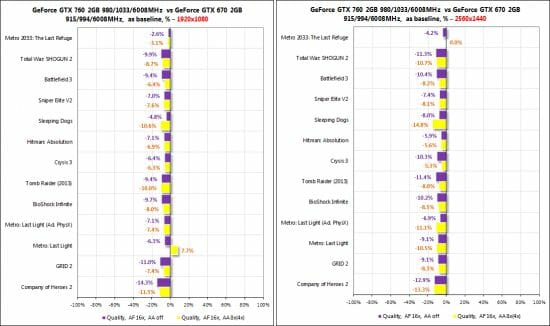
The new card isn’t much slower than the more expensive previous-generation product. The gap is only 7-8% at both resolutions. The gap between the GeForce GTX 770 and its senior cousin is larger:
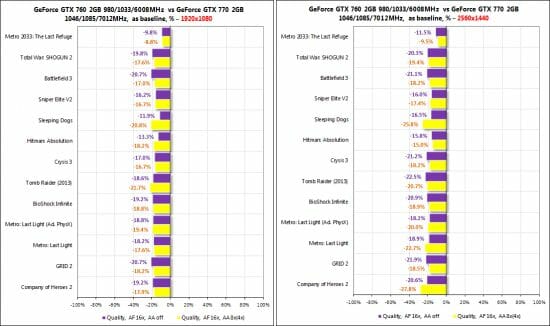
It is 16-17% at 1920×1080 and about 18% at 2560×1440 on average. The GeForce GTX 760 can be overclocked to narrow the gap and even win one of the tests:
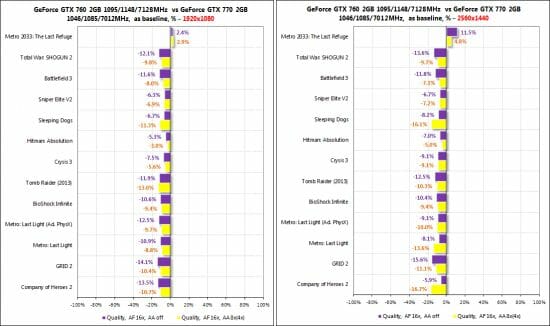
And now let’s compare the GeForce GTX 760 and the Radeon HD 7950 at their default clock rates. We can remind you that Nvidia’s presentation slide promised a 10-15% advantage in a large number of games. But what do we have in our own tests?
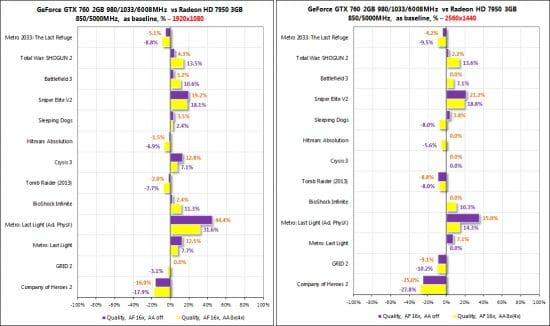
Well, the GeForce GTX 760 does look good against the more expensive opponent, yet the Radeon HD 7950 is ahead in such games as Metro 2033: The Last Refuge, Hitman: Absolution, Tomb Raider (2013), GRID 2 and Company of Heroes 2. The GeForce GTX 760 wins most of the other games, being especially impressive in the new Metro: Last Light and in Sniper Elite V2.
Below are additional charts for your reference:
- GeForce GTX 670 vs. Radeon HD 7950 at default frequencies;
- GeForce GTX 670 vs. Radeon HD 7950 during overclocking;
- Overclocked GeForce GTX 670 vs. nominal GeForce GTX 770.
Conclusion
First of all I would like to remind our readers that the MSRP of the Nvidia GeForce GTX 760 is set at $249. And even though the reality of the today’s market will not allow it to settle at this price soon enough, this new graphics accelerator seems to be a very appealing purchase from several different aspects. Even though its graphics processor is technically weaker, GeForce GTX 760 outperforms GeForce GTX 660 Ti due to its 256-bit memory, higher GPU clock speed and GPU Boost 2.0 technology. As a result, there is a 14% advantage that GeForce GTX 760 on average demonstrates over the GTX 660 Ti. Moreover, today we have also observed that the newcomer fell only a little bit (around 8%) behind a graphics card from a completely different category but from the previous generation – GeForce GTX 670, which can be easily eliminated by simply overclocking the new GeForce GTX 760. However, our today’s hero cannot catch up with the GTX 770 product even in the overclocked mode. Moreover, the recommended price difference between the two suggests that it could be quite logical to have something like a GeForce GTX 760 Ti come to fill in this gap. Moreover, GeForce GTX 760 competes quite successfully against a more expensive Radeon HD 7950, but again this conclusion is based on the recommended pricing. We are going to find out pretty soon what it will be like once this graphics card starts selling in stores. As for the weaknesses of the reference GeForce GTX 760, there is only one thing that needs to be pointed out at this time: not very efficient and noisy cooling system. Therefore, if you made up your mind about getting yourself one of these new graphics cards, we would highly recommend to check out proprietary designs with alternative coolers and incr4ased clock speeds.